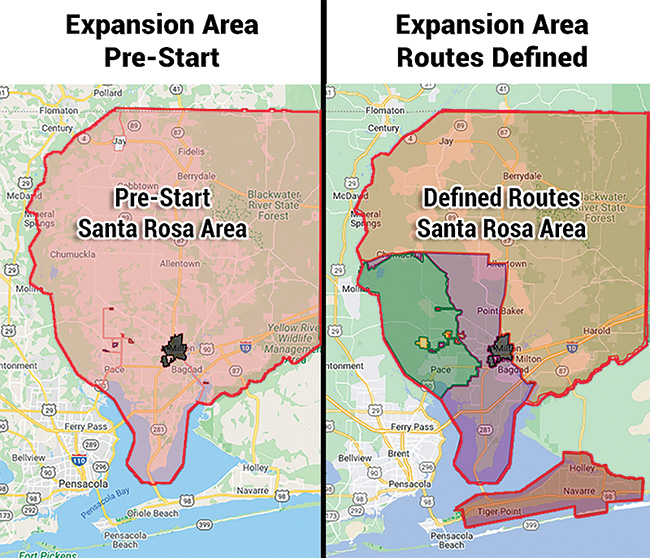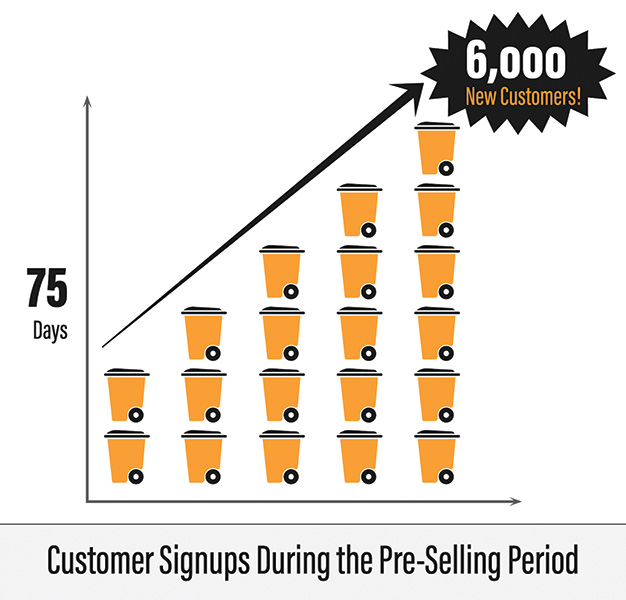How online signup helped Adams Sanitation add 6,000 new customers in 75 days, tripling their size.
By K. Ryan Hasse and Randy Sorensen
Growing your waste hauling business without exceeding your operational capacity can be challenging, especially if entering a new service area results in as many as 300 customers signing up daily—this was the case for Adams Sanitation. The upstart garbage collection company nearly tripled almost overnight using a strategy of pre-selling a new area with a defined start date and an online customer signup portal to measure and respond to customer interest in the new area. This article examines the results and processes they used to manage the new growth.
Overview
When the owners of Adams Sanitation learned of the exit of a franchise from neighboring Santa Rosa County, FL, they seized on the opportunity to enter the new market area. Adams moved aggressively to begin signing up customers for a late December 2020 start of service. Adams had a little more than 2,500 customers as of late 2020.
The initial signup phase resulted in an overwhelming number of phone calls to the office that peaked at 1,000 calls per day. The Adams team realized they could not meet the demand via phone only and turned to SalesStryke Software, creators of the TrashBolt online signup system, to handle the signup load. Adams was already using TrashBolt for online signup, so it was only a matter of modifying some aspects of the system to present the right options and information to the online customer.
The Importance of Data
As it turned out, the County moved to give the franchise area to another large hauler, causing Adams to take action to receive a permit to provide subscription service. The daily reports from TrashBolt showing the number of customers signing up for service in the new area provided excellent data to support the use of a subscription model. Owner Nathan Boyles said, “After the franchisee announced they would be pulling out at the end of the year, the County initially moved to give the franchise area to another large hauler under a reduced service model and without a competitive bid. Adams applied for a permit to serve the area under a subscription service model and became involved in a political fight to win the right to a permit. The pre-sale model helped us to show elected officials that many of their citizens wanted to choose their own trash hauler and did not want the franchise to be continued. This also allowed us to update our new potential customers on the status of our efforts to win a permit via e-mail and to mobilize them to communicate their concerns with the County.”
Not only was the TrashBolt sales data from the online portal valuable in the quest to get a permit, but it was also used to assist Adams in defining route zones and days of service. TrashBolt mapping specialists used the address data to show all customers in the area on a map and suggested ways to maximize efficiency by creating routes with good density.

Images courtesy of SalesStryke.
Advantages of Pre-Selling
Until the sales campaign begins, only an estimate can be made of potential new customers based on the demographics of the area. By pre-selling an area in advance, it is easier for the hauler to anticipate demand and prepare by adding carts, equipment, and personnel as needed. Rapid expansion, as in the case of Adams adding 6,500 new customers in approximately 75 days, does present challenges such as cash flow for cart and truck purchases. Adams’ approach to this challenge was to require a deposit at the time of signup to assist with the cost of equipment purchases. In just three months, the total deposits exceeded $300k, providing Adams with the cash required to expand into the new area.
Because of the circumstances surrounding the permit issue, Adams only had 40 days to start up service for the new customers. Nathan notes that without the pre-sales model, it is likely that the permit would not have been granted.
The Process
Adams began the process of requiring online signup in the new area by reaching out to the TrashBolt team to define the sales territory (mapping geofencing polygons within the TrashBolt system). TrashBolt began with one large map zone of the County with exclusions (carve outs) for cities with separate municipal contracts for the initial phase of the campaign. Later, using the signup data (what customers signed up and where), routes were defined by day and area. That route data was added to Adams’ TrashBolt system so additional customers could continue to sign up with the service day of the week included.
Having an online signup portal was an asset to the Adams team as it allowed them to include a direct link to the form as part of their digital marketing on social media and the web. An easy one-click path for potential customers.
Once mapping was in place, Adams crafted a message to include on the customer agreement form that is generated at the end of the signup process. The text from the top of the online customeragreement form for the new area reads: “Thank you for choosing Adams Sanitation! We are excited to serve the citizens of Santa Rosa County. We will be commencing our service in Santa Rosa County beginning January 1, 2021. All routes will be twice-weekly regular pickup. Our teams will collect any small items placed by the trash can (50 pounds or less) during regular pickup. Larger bulk items will be collected once a month as will limited yard debris. You can learn more about the details of our service here: www.adamssanitation.com/welcome-santarosacounty.
“Our team will be building our Santa Rosa routes in the weeks ahead. We will begin delivering carts in late November. We will begin a soft roll-out of our services in early December to ensure that there are no service gaps as ECUA begins to pull out, with service fully operational by January 1. There will be no charge for any services provided in December and we will communicate regularly with service updates. Regular pickup will either be on Mondays and Thursdays or Tuesdays and Fridays, we will notify you of your service schedule as soon as that information is available. Bulk and yard debris collections will be on separate days of the month, and you will be provided the schedule for the entire year prior to January 1.”
Adams also established a new page on their website with more information about their services and the timeline. A link to the new page was included on the customer agreement form. Once TrashBolt was set up and installed on the website, sales came flooding in via the online portal and sometimes topped 300 per day. To assist with onboarding such a high volume, TrashBolt provided daily sales reports in .csv format for import into Adams’s billing and operation software—a major time saver for the office staff.

The Importance of an Online Signup Portal
When asked what they might have done differently, the Adams team said that they would have limited the number of customer signups for the initial start by phasing in the county in smaller zones. Nathan also pointed out that “coordinating cart purchases from the manufacturer and then getting timely delivery to the customer ultimately proved to be the biggest challenge.”
Offering 24/7 online signup proved to be essential to the success of the pre-sale period in the new area. Even though additional customer service reps were added to help answer the high volume of calls, there was not enough time to fully train them and, as a result, many calls went unanswered.
“Without an automated signup process, we simply could not have onboarded as many customers as we did in the time period that we did. Despite our customer service failures on the phones, the majority of our customers that signed up online enjoyed a smooth experience because of the automated web portal,” said Nathan.
Effective Routing for a New Era
This case study shows that technology can play a significant role in the expansion process by reducing the number of incoming calls through a self-service online portal for customer signups. Furthermore, the data collected from the online sales can help the hauler gauge the growth rate and create effective routing for the new area. As a result of the expansion into Santa Rosa County, Adams tripled in size and has continued to grow. | WA
K. Ryan Hasse is CEO of SalesStryke Software, creators of the TrashBolt Software Online Shopping Cart System for haulers. Hasse was part of the GarbageMan, Inc. team, a Minnesota-based hauler. Garbageman was sold to Waste Management in 2018 after amassing more than 110,000 customers in just nine years. He now leads hauler clients to their growth objectives. TrashBolt Software has made its mark in the waste services industry by offering affordable, rapid deployment “buy now” functionality for haulers to deploy on their websites.
Randy Sorensen is the Project Manager for TrashBolt Software and assists clients with the implementation process and system maintenance after the launch. He has been with SalesStryke software since 2019.
For more information, visit www.trashbolt.com.
For a more detailed look at how an online shopping cart for haulers should be configured, visit https://wasteadvantagemag.com sales-and-marketing-best-practices-capturing-online-
buyers/.
